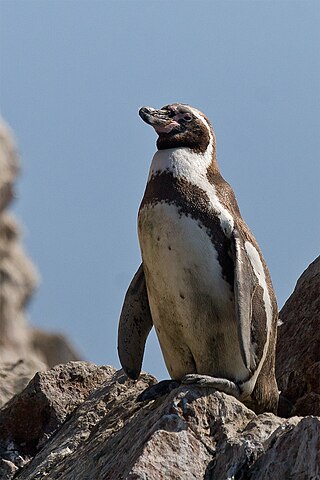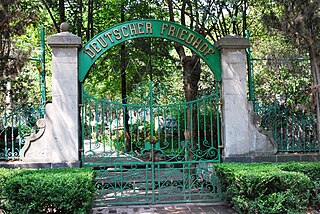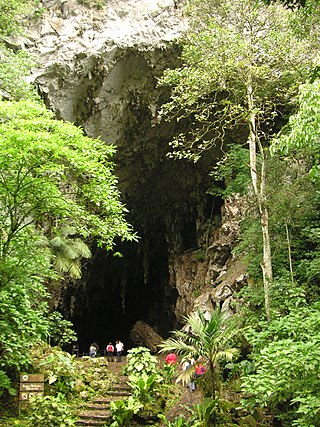Humboldt may refer to:

Friedrich Wilhelm Heinrich Alexander von Humboldt was a German polymath, geographer, naturalist, explorer, and proponent of Romantic philosophy and science. He was the younger brother of the Prussian minister, philosopher, and linguist Wilhelm von Humboldt (1767–1835). Humboldt's quantitative work on botanical geography laid the foundation for the field of biogeography, while his advocacy of long-term systematic geophysical measurement pioneered modern geomagnetic and meteorological monitoring.

The Humboldt–Toiyabe National Forest (HTNF) is the principal U.S. National Forest in the U.S. state of Nevada, and has a smaller portion in Eastern California. With an area of 6,289,821 acres (25,454.00 km2), it is the largest U.S. National Forest outside of Alaska.

The Humboldt penguin is a medium-sized penguin. It resides in South America, along the Pacific coast of Peru and Chile. Its nearest relatives are the African penguin, the Magellanic penguin and the Galápagos penguin. The Humboldt penguin and the cold water current it swims in both are named after the explorer Alexander von Humboldt. The species is listed as vulnerable by the IUCN with no population recovery plan in place. The current wild population is composed of roughly 23,800 mature individuals and is declining. It is a migrant species.

The East Humboldt Range is a mountain range in Elko County, Nevada, United States. It is located along the eastern edge of the upper watershed of the Humboldt River, which flows to the southwest from its source just north of the range. The range reaches a maximum elevation of 11,306 feet (3,446 m) atop Hole in the Mountain Peak. Most of the range is included within the Ruby Mountains Ranger District of the Humboldt-Toiyabe National Forest. In 1989, the United States Congress passed the Nevada Wilderness Protection Act establishing over 36,000 acres (150 km2) of the range as the East Humboldt Wilderness. The range takes its name from the Humboldt River. The name ultimately is derived from the German naturalist Alexander von Humboldt.

Tegel is a locality (Ortsteil) in the Berlin borough of Reinickendorf on the shore of Lake Tegel. The Tegel locality, the second largest in area of the 96 Berlin districts, also includes the neighbourhood of Saatwinkel.

Caripe is a town in Caripe Municipality in the mountainous north of the state of Monagas in eastern Venezuela. The official name of the town is Caripe del Guácharo 'Caripe of the Oilbird', referring to a colony of nocturnal birds which lives in a nearby cave, the Cueva del Guácharo. The species was unknown to science until 1799 when Alexander von Humboldt came to Caripe during his Latin American Expedition.

German Mexicans are Mexican citizens of German origin. Most documented ethnic Germans arrived in Mexico during the mid-to-late 19th century and were spurred by government policies of Porfirio Díaz. Many of them took advantage of the liberal policies in Mexico at the time and went into merchant, industrial, and educational ventures. However, others arrived without any or much capital as employees or farmers. Most settled in Mexico City and the surrounding states of Puebla and Veracruz as well as the northern states of Sonora, Sinaloa, Jalisco, and Chihuahua. Later settlers headed south towards the Yucatán Peninsula. Significant numbers of German immigrants also arrived during and after both World Wars. The historic strength of German-Mexican relations has contributed to Mexico having the fourth largest German population in all Latin America behind Brazil, Argentina and Chile.

The Guácharo Cave National Park is located 12 km (7.5 mi) from the town of Caripe, Monagas, Venezuela. It has as its centerpiece a large limestone cave.

Colegio Alemán Alexander von Humboldt, A. C. is a network of German-language primary and secondary schools based in Greater Mexico City.

German Peruvians are Peruvian citizens of full or partial German ancestry. In general, the term is also applied to descendants of other German-speaking immigrants, such as Austrians or the Swiss, or to someone who has immigrated to Peru from German-speaking countries.
Ruby Mountains National Forest was established as the Ruby Mountains Forest Reserve by the U.S. Forest Service in the Ruby Mountains of northeastern Nevada on May 3, 1906 with 423,660 acres (1,714.5 km2). It became a National Forest on March 4, 1907. On July 1, 1908 the entire forest was added to Humboldt National Forest and the name was discontinued until Ruby National Forest was established from Humboldt in 1912. The lands are presently part of the Ruby Mountain District of Humboldt-Toiyabe National Forest.
Alexander von Humboldt was a German naturalist and explorer.

Alberto Kalach is a Mexican architect.
German Venezuelans are Venezuelan citizens who descend from Germans or German people with Venezuelan citizenship. Most of them live in Caracas, Maracaibo, Valencia, Colonia agrícola de Turén, El Jarillo, and Colonia Tovar where a small-reduced and decreasing minority of people speak the Colonia Tovar dialect, a German-derived dialect from their ancestry, and the Spanish language.
Colegio Humboldt may refer to the following German international schools in Latin America:

The Paradise Valley Ranger Station, located at 355 S. Main St. in Paradise Valley, serves a district of the Humboldt-Toiyabe National Forest in Humboldt County, northwestern Nevada. It has also been known as the Paradise Valley Guard Station.
Humboldt-Schule may refer to any number of schools named after Alexander von Humboldt:
The protected areas of the Sierra Nevada, a major mountain range located in the U.S. states of California and Nevada, are numerous and highly diverse. Like the mountain range itself, these areas span hundreds of miles along the length of the range, and over 14,000 feet of elevation from the lowest foothills to the summit of Mount Whitney.